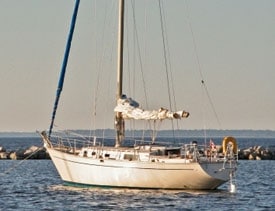
A teardrop-shaped hull, wide beam, discreet reverse transom, and long overhangs might be the hallmarks of a vintage racing boat, but Ted Brewer designed the Morgan 382 as a cruiser, not as a racer that could also be cruised. From 1977 to 1986, Morgan Yachts and its successor, Cat-alina-Morgan, built nearly 500 of the Morgan 382 and its later configurations, the 383 and 384. Owners have taken them everywhere.
Visually, the boat is balanced and well proportioned, and the low cabin trunk and 6-inch bulwarks help keep the profile trim. At upward of 17,000 pounds on a waterline of 30 feet 6 inches, the boat is almost in the heavy-displacement category. The hull, however, with its elongated fin keel, skeg-attached rudder, and roundish bilge, isn’t that of a slow cruiser.
The all-wood interior offers volumes of room and storage. The head of the double quarter berth to starboard serves as the seat for the nav area; opposite is a large and efficient galley. In the saloon, the L-shaped seat to port only seats two comfortably at the drop-leaf table. A wide settee and a narrow pilot berth occupy the starboard side. The head is roomy and has a fully enclosed shower, but because of the boat’s fine entry, the V-berth is relatively small. On the 384 version, four cowl vents improved the previously poor ventilation.
This boat brought some innovations to the market in 1977. The topsides and the deck were cored with synthetic foam at a time when balsa and plywood were the norm. Morgan also introduced a novel drain system: All deck drains connect to a PVC tube that runs across the boat aft and under the cockpit. Owners call it the “torpedo tube.”
The 382s and later sister ships are generally well built, albeit on the light side. One quirk, however, is that the aft part of the keel houses a 15-gallon integral holding tank, which makes for neither a strong keel nor easy service on the tank. The lead ballast is encapsulated in the forward part of the keel.
Under sail, the motion is predictable and comfortable, and the wide deck offers excellent footing with many flat surfaces. The practical and well-protected cockpit commands a clear view in all directions. The helm is responsive, but directional stability with the wind aft of the beam isn’t great. Overall, the boat is stiff and fast; it points high, and it cuts through chop easily. Aboard our 1982 Morgan 383, Serenity, in 30-knot winds and 5-foot seas on Chesapeake Bay, we’ve surfed at 9.6 knots. Serenity has a Perkins 4-108 and, under power, typically registers 6.2 knots at 1,600 rpm while consuming half a gallon of fuel per hour.
The anchoring system, consisting of a single anchor roller and a foredeck locker, was seen as modern at the time. In reality, it’s inadequate for serious cruising, and many owners have retrofit a second roller and sturdier mooring bitts and cleats.
Some use the quarter berth for storage. All items that need maintenance or repair are easily accessible. With a modified or enlarged saloon table, the interior becomes cozy and functional, though the wood makes it a little dark.
Boats in the Morgan 382/ 383/384 family list from about $40,000 to nearly $80,000. They may not turn heads in harbors, but they’ll take good care of their crews at sea or on the hook, in light air or in heavy weather. Owners trade tips and chat through a website.
Morgan 382 Specs
LOA: 38′ 4″ (11.68 m.)
LWL: 30′ 6″ (9.30 m.)
Beam: 12′ 0″ (3.66 m.)
Draft: 5′ 0″ (1.52 m.)
Sail Area (100%): 668 sq. ft. (62.1 sq. m.)
Ballast: 6,800 lb. (3,084 kg.)
Displacement: 17,200 lb. (7,802 kg.)
Ballast/D: .40
D/L: 271
SA/D: 16.0
Water: 95 gal. (360 l.)
Fuel: 40 gal. (152 l.)
Engine: Various diesels
Designer: Ted Brewer








